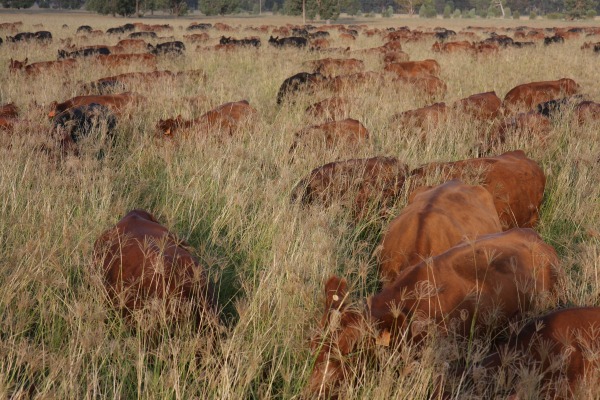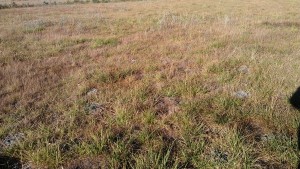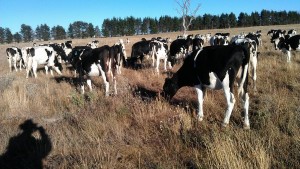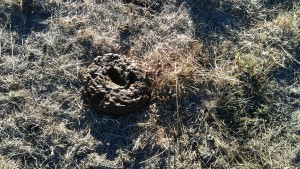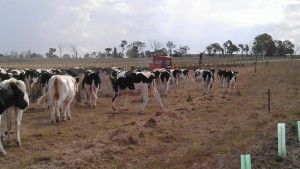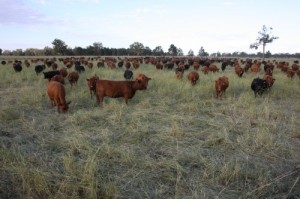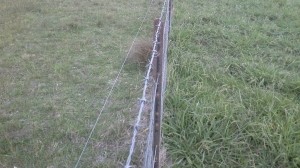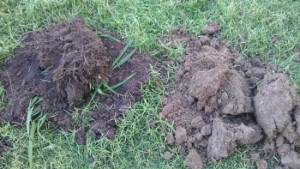I mentioned a few weeks back the feedback I had from Cam at Uralla (NSW, Australia) about how he is optimising animal performance in his planned grazing operation on the New England Tablelands of NSW. This is something that Cam, like us, has had trouble optimising in the past. But Cam is turning this around with some tweaking of his management; he doesn’t profess to fully understand why he is getting the outcomes he is, but with his income reliant on consistent weight gain and meeting growth targets of dairy heifers, he has got a pretty good handle on what is working and what is not. He takes on heifers from around 120 – 180kg and carries them through until the point of calving, during which time he is regularly weighing, observing and monitoring and changing tact to optimise performance. He is paid for weight and size gains.
It is the density of stocking and the time between moves that Cam has been playing with. He has practiced time controlled grazing for some 25 years now, but it is only within the last few years that Cam has really felt he’s getting a handle on how to optimise animal performance – which is also coinciding with better pasture performance. Let’s look at what Cam has been doing.
(Please refer back to my previous blog on “Animal Performance under Planned Grazing” if you need to get up to speed on how planned, rotational grazing works).
Farm set up
Until 2012 Cam had much of his property broken into wagon wheel style paddocks with a cup and saucer trough/tank in the centre and each wedge being around 8ha. With 3 mobs, this meant moves every 4 or 5 days in the slow growth season. The cattle were removing about 7-800kg/ha of dry matter in this period. The pastures are 50-80% fescue (perennial cool season grass), with clover and other grasses and forbes mixed in too. Despite the fescue being the dominant species, there is still up to 30-40 species in many areas of the farm – a legacy of his past planned grazing.
Since November 2012, Cam has pulled some of the wagon wheels out and changed these areas to strips of 4ha which are cut into half, leaving 2ha grazing blocks (& setup so that those paddocks can easily be far smaller with existing water & permanent fencing), with portable water troughs that tap into a riser at the middle of the tree lane or strip between paddocks. The lanes are 800m long by 48m wide with the water point in the middle – which is where he places the fence to divide the strip in 2.
The Results
It is since this change to 2ha blocks and the associated increase in grazing densities that Cam has seen the best improvements in both stock condition and pasture condition. Remember that this grazing system is relying on root exudates, soil biology, dung and manure for self-perpetuating nutrition with no fertilizer used on loamy granite soils.
Since the paddock size changes, there has certainly been advantages from the increased grazing densities.
Table 1. Average grazing densities, weight gains and dry matter production averaged across each of the two block sizes from the farm, understand this is early days with the oldest 2.0 ha paddocks being in operation for 4 years – these have been maintaining and improving for that time.
|
Paddock Size |
Grazing Density |
Pasture Growth (DDH) |
Average daily weight gain (kg/hd/day) |
48% more grazing days/ha and 4.6% increase in livestock weight gain from the 2ha blocks |
|
8ha |
1-200 dse/ha |
1197 |
0.65 |
|
|
2ha |
6-700 dse/ha |
1789** |
0.68 |
DDH = Dry sheep equivalent days per hectare.
It should also be noted that some of the current 8ha blocks were actually some of the better producing blocks prior to other blocks being altered to 2ha.
These results are based on real figures from Cam’s past grazing charts.
So, Cam is not only putting on more weight on the cattle each day, but is also getting more animal grazing days per hectare, which is a reflection of more grass or pasture (48% more, based on the numbers above!). This means he can either stock more animals, leave it longer until returning to this paddock or he can leave more behind after each graze, which is what Cam is planning to do. Currently however, with a dry season he is still eating into these reserves. He does however, intend to build a bigger feedbank when the season turns.
With a poor season, Cam is currently grazing down close to the lowest reserve he likes to go – which is 1500kg/ha DM. He knows that he has enough feed for current stock to get through to late September. With the backgrounding of heifers, there are fairly regularly stock entering and leaving the property, so without a break in the season before then, Cam will not replace the cattle that leave, thus reducing his stock numbers.
Ideally, he would like a residual of around 2000+kg/ha DM, which Cam believes he will be able to build following more intensified grazing. This is Cam’s ‘living drought reserve’ – which takes the place of pulling bales of hay out of a shed.
Specifically, currently for each block (in mid-winter)
- The 8ha blocks are being grazed for around 5 days, with 7-800kg of dry matter removed.
- The 2ha blocks are being grazed for around 1 ½ days, with around 1000kg DM/ha removed.
In the current dry season he is grazing both areas to a fairly similar base level but in more average seasons he likes to increase the residual level to 2000 kg+ on the whole property which considerably improves plant recovery time.
Leaving a greater residual also means that the plants have a greater root mass and the plant regrows & responds from photosynthesis rather than root reserves.
I quizzed Cam on a few things to determine why there is the difference in performance between these two systems – things like mob behaviour, amount of litter knocked to the ground, soil scuffing, evidence of preferential grazing of species. None of these appeared to be different between the paddock sizes. The higher stock density smaller paddocks however, appear to quite quickly become denser & improve quickly after a number of graze/ rest cycles.
There was a detectable difference in the manure/urine spread and subsequent pasture health, with it being better toward the water point or centre of the wagon wheel in the 8ha blocks, but was more evenly spread in the 2ha lanes. This is reflected in the pastures not only having more dry matter but looking lusher and a richer green in the growing season.
The other thing Cam noted is that there is great ground cover in both block sizes, but the ground cover in the 2ha blocks was more growing ground cover, while in the 8ha blocks it was just the dry matter litter covering the ground between larger plants.
This is supported by other high density graziers like Joel Salatin, who says that the density of the mob “reduces individuality, it stimulates aggressive, less selective grazing habits”. ”The animals become less selective. They don’t have the time or opportunity to be picky about which plants they eat. The result is more even mowing and a tremendous reduction in normally ungrazed plants. This pushes succession of the good species ahead.”*
Cam believes that the 2 days or less between moves may be a critical time period. “It appears to me anyway, that the short graze periods – less than 2.5 days appear to help the animals cope with low quality dry feed as they are getting ‘fresh’ feed every couple of days which helps move the dry roughage through the rumen and also helps balance their diet”, Cam explained.
Here is a 2ha paddock prior to grazing on the 28th January this year this paddock has been in 2.0 ha paddocks for approx 15 months – approx 5 graze /rest cycles – note the plant density & evenness of the previous graze.
This paddock below was on 28th Jan – it’s first graze as a 2.0 ha paddock from 8 ha paddocks note the different previous graze & plant density This mob put on 0.85kg/hd/day for the month of January, on what was certainly not lush feed – as you can see.
You can see that their rumens are obviously running happily by the nice soft manure pads.
The mob below gained 0.66kg/hd/day for February, which was a month where feed quality dropped in the last week, with it being cold and wet. Standing (golden) dry grass turned black following the rain and there was little new growth of any use from the rain.
(As a side, the tractor in the picture is spreading oat seed which was pasture cropped via ‘ploughing’ in with cattle hooves after rain which was forecast eventuated).
“I do not have all the answers, but we seem to be getting some reasonable results with our cattle in fairly average seasons”, says Cam, who has had below average rainfall for the past 3 years.
What about supplementation?
Cam used to supplement with urea, but has not done so since 2010. He has also played with a whole number of different supplements over time, ranging from loose lick free choice minerals to all in one blends. The one and only supplement he now uses is Himalayan rock salt. This rock salt is 80% NaCl (or what we might know as table salt), while the remainder is made up of over 80 naturally chelated minerals.
Cam believes the rock salt that they consume encourages them to drink more water, which may help with passing more lignified feeds through the gut of his cattle. He also believes the chelated minerals are helping their manure and to keep their coats healthy, which are a strong indicator of health.
What is causing the performance difference between the stocking densities?
So it seems we may have been underestimating how well livestock selectively graze? I mean we know that they are good at it to the point that set stocking will result in the loss of the more desirable species. But are we underestimating that in what would traditionally be thought of as a relatively high stocking density (such as Cam’s previous 8ha paddocks) – these species losses are still occurring? When the density is increased to a higher level, as mentioned before, there is such competition between animals that they are forced to consume a complete mix of the species and plant components (higher energy grass tips as well as lower energy bulk) all in one – which evens out the plane of nutrition. This more even graze means that the following graze there is a higher % of the available feed that is fresher. Now this doesn’t necessarily mean green and fresh everytime, but it will mean that lignified material does not miss several grazes and sit there for possibly 12 months or more, but rather is likely to be grazed or bashed down each graze – if not every second graze.
In aiming to leave more dry matter behind after a graze, Cam is doing similar to other well known graziers who are practicing ‘tall grazing’, high density management. Rather than trying to return to a paddock when the grass is in a recovered, yet still vegetative state, ‘tall grazing’ is keeping the grass in the steeper part of the growth curve and grazing when grass is at least in the boot, through to seeding. It is not grazed down so severely. This is compared with knocking it down to the bottom ‘shallow’ part of the s shaped growth curve. This is well discussed in Allan Savory’s ‘Holistic Management’, but only from a viewpoint of pastures, not animal performance.
Cam is aiming for this ‘tall grass grazing’, but is currently not achieving this with every graze cycle. With several dry seasons since he began the higher density grazing, he is still needing the feed to get ahead enough that he can continue to graze in this ‘tall graze’ manner each cycle. Cam reports that the graze cycles since beginning the high density grazing when he has achieved the tall grass grazing is when he has achieved the best livestock weight gains.
Energy!
And in answering the question of animal performance when grass is at a more mature state, Joel Salatin explains it in this manner – by relating it to corn silage.
“Think about corn as a glorified grass. It is, you know. Would it be cut before tasseling? Before an ear formed? Of course not. Why? Because corn silage, as a fermentation product, needs starch for the process. Fermentation is all about sugars. And it takes time for a grass to move from protein to sugar. Imagine in your mind’s eye that corn plant ready for silage cutting. The tassels are completely shattered. Ears are full and plump. The leaves are green, but the base of the stalk has already turned brown, perhaps up 12-18 inches from the soil horizon. The plant is clearly mature, not growing any more. At all.
Now imagine, in your mind’s eye, what orchard grass, switchgrass, fescue or bluegrass, would look like at that same stage of maturity. Would there be seed heads? Yes. Would it be browning down at the base of the tallest stems? Yes. Would it be too mature to graze? No. In fact, it would be just right.”1
He makes this comparison because a ruminant gut is just a fermentation vat, like with the silage. ”As the plant matures it concentrates energy”2. Whether feeding an animal high protein feed or high energy feed, either way, the fermentation process or microbes in the gut still need to be fed with energy. In the case of the tall grass grazing, this is satisfied with the high energy carbohydrates; in the case of young, fresh grass growth, the protein is high relative to the energy. In this case the energy to feed the gut microbes comes from breaking down the proteins to get to underlying energy stores. The energy is gained, but ammonia is the side product, which is toxic to the animals and places pressure on liver and kidneys as they rid the animal of it. Such processes are energy intensive.3
Taking the taller grass energy advantages to the extreme is Abe Collins, a dairy farmer in Vermont, U.S. He restricts morning grazing, but moves the cattle 4 or more times between 11am and 6pm in the afternoon, when sugar levels (energy) are highest. This has awarded him with an extra 2.25kg of milk production each day.4
Another point to note from tall grazing is that more ground litter is possible. Joel Salatin again – “Leaves don’t fall when they’re green; they fall when they’re brown and stiff. Grass doesn’t lodge when it’s green; it falls over when it’s brown and brittle. Nature feeds soil with mature, lignified carbon that places meals on top, not knifed in or plowed in”.5
We have practiced higher densities in our blocks where it is possible, where we had enough density that we were moving every day, but with not great animal performance. I think our issue was that we were grazing down too far. As I mentioned when I blogged a few weeks back, we were feeling the need to get the dry matter eaten down, so as to be fresh for the next graze and this was likely affecting animal performance. The key to the tall grass grazing may well be keeping the plane of nutrition even, and this is what we were not doing in eating the grass so low – or maybe we needed greater density.
Not only that, by leaving more leaf on the plant, we will get quicker recoveries, because it will also mean more root mass left, from which the energy retained can more readily begin leaf growth again.
By having a greater root mass left behind, we are also not only drawing on greater energy in the root reserves for growing new leaf, but in dry times we have a greater amount of the soil from which to draw moisture, thus helping to have more resilience in dry times.
Back to Cam and his outcomes. He is clearly doing an amazing job, which can be seen from these soil shovels from Cam’s property versus his neighbours set stock operation just through the fence.
“12 years ago, both sides of the fence were similar, with my property likely worse, if anything. Our soil tested lower organic matter and carbon levels”, Cam said.
And just look at it now.
One final note on high density grazing or the more frequent moving of cattle. With more regular moves, the livestock can become habitual as you open the tape for them each day. It can get to the point of them standing, bellowing, waiting to be let into the fresh paddock of feed – regardless of what is left in the last block. Upon being let in to the next block, they will do several laps of the paddock before settling. This is a stress to animals and will affect performance. It makes for easy moving, but not for low stress, high performance animals. Something else we have experienced and learnt from along the way. But I will leave the detail on this for another week.
Thanks to Cam for sharing his experiences with us. Real life experiences such as this allow for great learning for the rest of us, so thank you. If any of you have other stories of challenges and successes I would love to hear them.
References
1,2 & 5 Salatin, J. (2008) An Aggressive Approach to Controlled Grazing Tall Grass Mob Stocking. Acres.Vol.38 No.5.
3&4 Collins, A. Grazing Taller Grass. http://www.newfarm.org/features/2006/0606/grazingtall/collins.shtml 25th July 2014.

